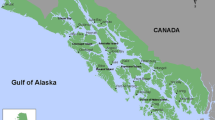Abstract
We develop a "perceived hazard" model that estimates consumers' endogenous risk perceptions about products. These perceptions are then linked to a model of product choice. Our approach thus departs from the expected utility model that depends upon external risk assessments. In an application to recreational fishing, we find that anglers' perceived hazards associated with fish consumption advisories do affect product (recreational site) choice. Anglers' perceptions also affect welfare measures because the benefits of contaminant removal flow from these perceptions. The perceived hazard/product choice model is applicable to a wide variety of risky choices consumers face.
Similar content being viewed by others
References
Ben-Akiva, M.E. and S.R. Lerman. (1985). Discrete Choice Analysis: Theory and Application to Travel Demand. Cambridge, MA: MIT Press.
Burger, J. et al. (1999). "Fishing in Urban New Jersey: Ethnicity Affect Information Sources, Perception, and Compliance," Risk Analysis 19, 217–228.
Chen, H.Z. and S.R. Cosslett. (1998). "Environmental Quality Preference and Benefit Estimation in Multinomial Probit Models: A Simulation Approach," American J. Agricultural Economics 80, 512–520.
Flynn, J., P. Slovic, and C.K. Mertz. (1994). "Gender, Race, and Perception of Environmental Health Risks," Risk Analysis 14, 1101–1108.
Jakus, P.M., D. Dadakas, and J.M. Fly. (1998). "Fish Consumption Advisories: Incorporating Angler-Specific Knowledge, Habits, and Catch Rates in a Site Choice Model," American J. Agricultural Economics 80, 1019– 1024.
Jakus, P.M. et al. (1997). "Do Sportfish Consumption Advisories Affect Reservoir Anglers' Site Choice?" Agricultural and Resource Economics Review 26, 196–204.
Jehle, Geoffrey and Phillip Reny. (1998). Advanced Microeconomic Theory. Reading, MA: Addison-Wesley.
Kahneman, D. and A. Tversky. (1979). "Prospect Theory: An Analysis of Decisions Under Risk," Econometrica 47, 263–291.
Krinsky, I. andA.L. Robb. (1986). "On Approximating the Statistical Properties of Elasticities,"Rev. Economics and Statistics 68, 715–719.
Machina, M.J. (1987). "Choice Under Uncertainty: Problems Solved and Unsolved," J. Economic Perspectives 1, 121–154.
McClusky, J.J.and G.C. Rausser. (2001). "Estimation of Perceived Risk and Its Effect on Property Values," Land Economics 77, 42–55.
Montgomery, M. and M. Needelman. (1997). "The Welfare Effects of Toxic Contamination in Freshwater Fish," Land Economics 73, 211–223.
Morey, E.R. andD.M. Waldman. (1998). "Measurement Error in Recreation Demand Models: The Joint Estimation of Participation, Site Choice, and Site Characteristics," J. Environmental Economics and Management 35, 262–276.
Morey, E.,W. Breffle, and D. Waldman. (2000). "Combining Sources of Data in the Estimation of Consumer Preferences: Estimating Damages to Anglers from Environmental Injuries," In S. Polasky(ed.),Proceedings of the W-133 Regional Project.
O'Connor, R.E., R.J. Bord, and A. Fisher. (1999). "Risk Perceptions, General Environmental Beliefs, and Willingness to Address Climate Change," Risk Analysis 19, 461–471.
Pflugh, K.K. et al. (1999). "Urban Anglers' Perception of Risk from Contaminated Fish," The Science of the Total Environment 228, 203–218.
Shaw, W.D. and J.S. Shonkwiler. (2000). "Brand Choice and Purchase Frequency Revisited: An Application to Recreation Behavior," American J. Agricultural Economics 82, 515–526.
Starmer, C. (2000). "Developments in Non-Expected Utility Theory: The Hunt for a Descriptive Theory of Choice Under Risk," J. Economic Literature 38, 332–382.
Train, K., D. McFadden, and R. Johnson. (2000). "Discussion of Morey and Waldman's Measurement Error in Recreation Demand Models," J. Environmental Economics and Management 40, 76–81.
Viscusi, V.K. (1989). "Prospective Reference Theory: Toward an Explanation of the Paradoxes," J. Risk and Uncertainty 2, 253–264.
Viscusi, K. and W.N. Evans. (1998). "Estimation of Revealed Probabilities and Utility Functions for Product Safety Decisions," Rev. Economics and Statistics 80, 28–33.
Viscusi, V.K.,W.A. Magat, and J. Huber. (1999). "Smoking Status and Public Responses to Ambiguous Scientific Risk Evidence," Southern Economic J. 66, 250–270.
Von Neumann, J. and O. Morgenstern. (1947). Theory of Games and Economic Behavior, 2nd Edition. Princeton, NJ: Princeton University Press.
Walker, V.R. (1995). "Direct Inference, Probability, and a Conceptual Gulf in Risk Communication," Risk Analysis 15, 603–609.
White, H. (1980). "A Heteroscedasticity-Consistent Covariance Matrix Estimator and a Direct Test for Heteroscedasticity," Econometrica 48, 817–838
Author information
Authors and Affiliations
Corresponding author
Rights and permissions
About this article
Cite this article
Jakus, P.M., Shaw, W.D. Perceived Hazard and Product Choice: An Application to Recreational Site Choice. Journal of Risk and Uncertainty 26, 77–92 (2003). https://doi.org/10.1023/A:1022202424036
Issue Date:
DOI: https://doi.org/10.1023/A:1022202424036




